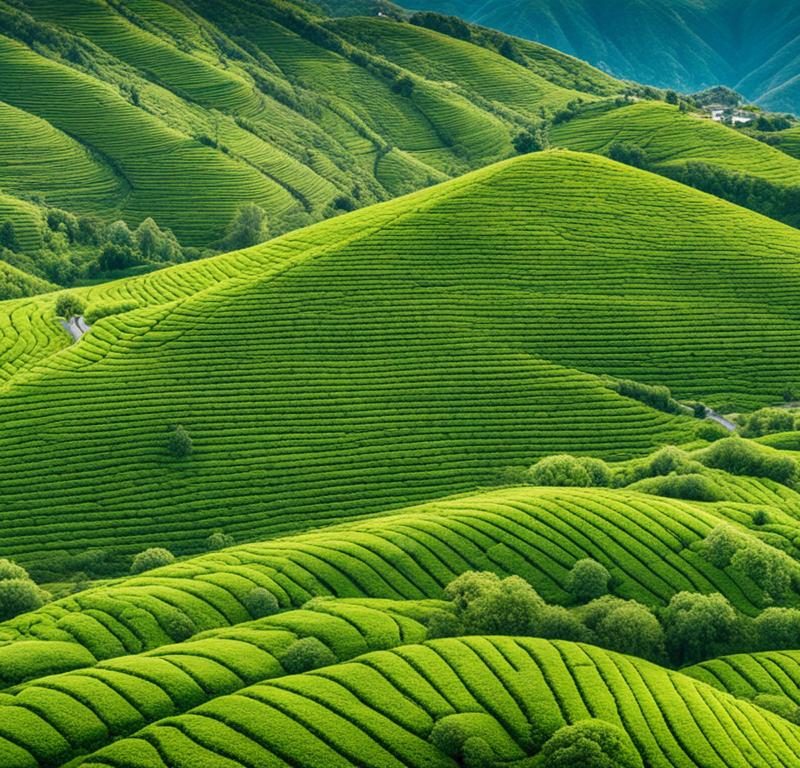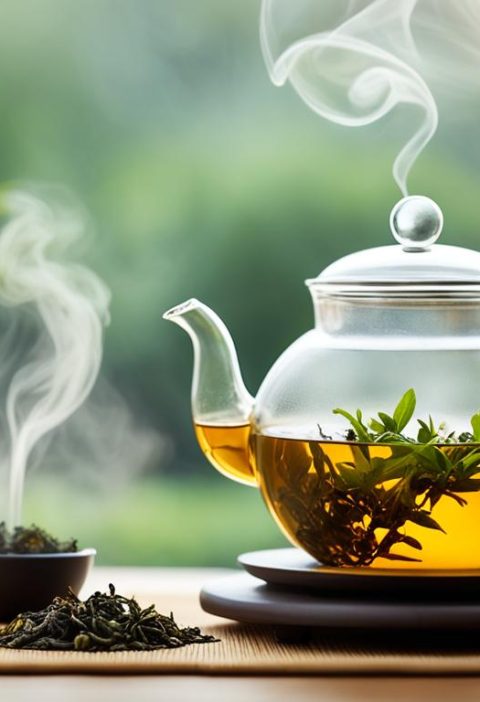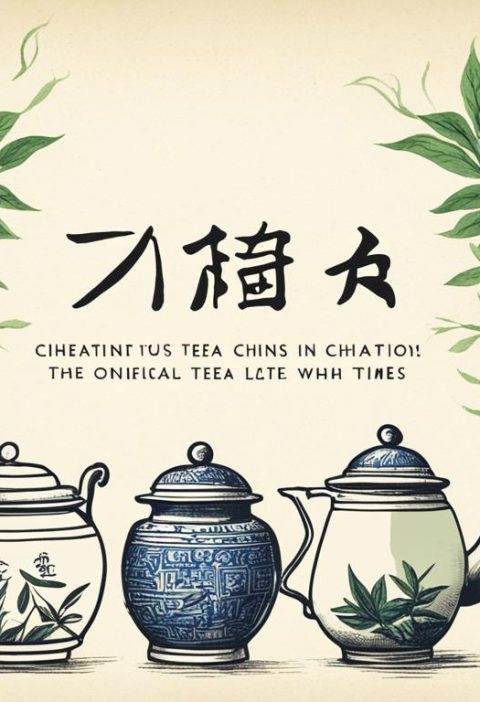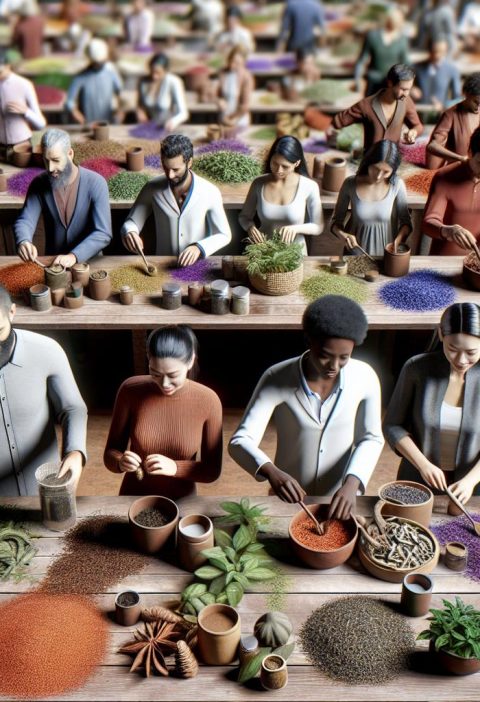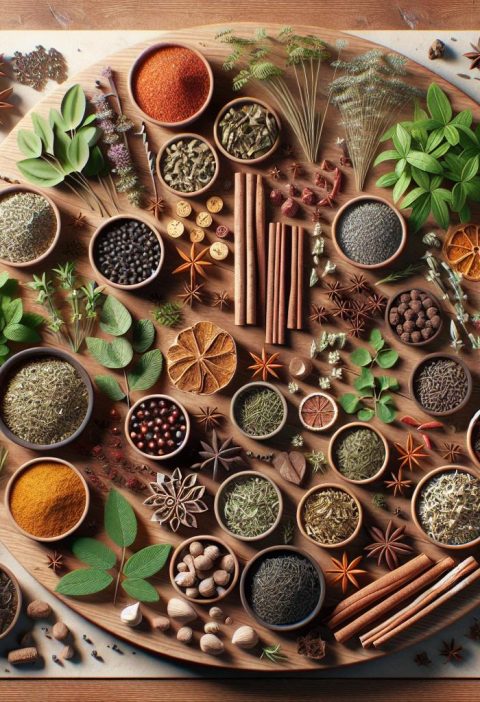If you’re a fan of green tea, you know that not all teas are created equal. The flavors and qualities of green tea can vary greatly depending on the region in which it is grown. In this article, we’ll take a journey through the best tea regions for green tea in Japan. From the birthplace of matcha in Uji, Kyoto, to the largest tea-producing region in Shizuoka, we’ll explore the finest places for green tea production. Each region has its unique characteristics that contribute to the exceptional flavors and craftsmanship of Japanese green teas. So grab your teacup and join us as we delve into the world of green tea in Japan.
Key Takeaways:
- Japan is famous for producing some of the world’s finest green teas, with Kyoto, Shizuoka, Kagoshima, and Saitama being some of the best tea-growing regions.
Top Tea-Growing Regions in Japan
Japan is renowned for its production of exquisite green tea, and several regions in the country stand out as the best tea-growing areas. Let’s explore some of these top regions known for their exceptional teas.
Uji in Kyoto Prefecture
Uji, located in Kyoto Prefecture, is considered one of the most famous tea-growing regions in Japan. The region’s tea fields are surrounded by picturesque landscapes and have been producing high-quality green tea for centuries. Uji is particularly renowned as the birthplace of matcha, a powdered green tea with a vibrant and distinct flavor. The matcha produced in Uji is prized for its richness and smoothness.
Shizuoka Prefecture
Shizuoka Prefecture is the largest tea-producing region in Japan, accounting for over 40% of the country’s tea production. The region’s tea plantations benefit from the nutrient-rich soil provided by the iconic Mount Fuji and the natural slopes of the hills. Shizuoka green teas are known for their fresh and earthy flavors, reflecting the region’s diverse climate and rich biodiversity.
Kagoshima Prefecture
Kagoshima, located in southern Kyushu, is the second-largest tea-growing region in Japan. The warm and humid climate of Kagoshima creates favorable conditions for tea cultivation, resulting in teas with extraordinary balance, body, and color. The region’s sencha, a steamed green tea, is particularly famous and highly regarded for its distinct flavors.
Sayama in Saitama Prefecture
Sayama, situated in Saitama Prefecture, is known for its rich and bold green teas. The teas produced in Sayama have deep green color, distinct aromas, and a unique sweetness with a bold flavor profile. Sayama tea is often described as having a grassy and floral aroma, making it a popular choice among tea enthusiasts.
These are just a few of the top tea-growing regions in Japan. Each region has its own distinct qualities and flavors, influenced by factors such as climate, altitude, and soil type. Exploring teas from these regions allows us to appreciate the diversity and craftsmanship of Japanese green tea.
Uji, Kyoto: The Birthplace of Matcha
When it comes to matcha, there is no place more synonymous with its origin and quality than Uji in Kyoto. This picturesque region is considered the birthplace of matcha in Japan, and its tea farming traditions date back centuries.
Uji matcha is known for its vibrant green color, smooth texture, and rich umami flavor. The secret lies in the meticulous cultivation and production methods employed by the tea farming families of Uji. The small town of Wazuka in Uji is particularly renowned for its tea farms, where generations of skilled farmers have dedicated themselves to cultivating the finest green tea.
What sets Uji matcha apart is the region’s unique climate, soil composition, and traditional tea-growing techniques. The cool, misty weather and fertile soil create the perfect conditions for tea cultivation, resulting in leaves that are packed with nutrients and flavor.
Uji matcha is prepared using stone grinding techniques, transforming the hand-picked tea leaves into a fine powder. This powder is then whisked into a frothy concoction, creating a delightful and invigorating beverage that has captivated tea enthusiasts worldwide.
The Flavor Profile of Uji Matcha
Uji matcha offers a unique flavor profile that sets it apart from other green teas. Its taste is characterized by a perfect balance of umami, sweetness, and slight bitterness. The velvety texture and vibrant green color of Uji matcha further enhance the overall sensory experience.
The flavor notes of Uji matcha can vary depending on the specific cultivar and processing methods. However, common flavor profiles include vegetal, grassy, and slightly nutty undertones. The tea’s captivating aroma further adds to the sensory journey, transporting you to the scenic tea fields of Uji.
| Flavor Profile | Aroma | Color |
|---|---|---|
| Umami, Sweetness, Slight Bitterness | Grassy, Vegetal, Nutty | Vibrant Green |
Uji matcha is not only a treat for the taste buds but also a feast for the eyes. Its vibrant green color is visually stunning, making it a popular choice for tea ceremonies and culinary creations.
Whether enjoyed as a traditional tea ceremony beverage, incorporated into a ceremonial-grade culinary masterpiece, or used in contemporary matcha lattes and desserts, Uji matcha is the epitome of Japanese tea craftsmanship.
So, indulge in a cup of Uji matcha and experience the flavors and aromas that have made this region famous for its exceptional green tea. Discover the birthplace of matcha and immerse yourself in the rich history and artistry of Uji’s tea farming culture.
Shizuoka: Japan’s Largest Tea-Producing Region
In Japan, the region of Shizuoka stands out as the largest producer of tea, accounting for over 40% of the country’s tea production. With its vast tea plantations and a longstanding tradition of tea cultivation, Shizuoka has earned a reputation for producing high-quality green teas.
What sets Shizuoka apart is its rich natural resources. The nutrient-rich soil, nurtured by the majestic presence of Mount Fuji, provides ideal conditions for growing tea. Additionally, the natural slope of the region’s hills facilitates excellent drainage, ensuring the tea plants receive the right amount of water.
The combination of favorable climatic factors, such as the mild winters and warm summers, further contributes to the exceptional quality of Shizuoka green tea. The region’s teas are known for their fresh and earthy flavors, offering tea enthusiasts a unique and delightful drinking experience.
To illustrate the significance of Shizuoka in tea production, here are the top tea-producing regions in Japan:
| Rank | Region | Percentage of Tea Production |
|---|---|---|
| 1 | Shizuoka | 40% |
| 2 | Kagoshima | 20% |
| 3 | Kyoto | 18% |
| 4 | Mie | 7% |
| 5 | Fukuoka | 4% |
Shizuoka’s dedication to tea production and its commitment to quality have made it the cornerstone of the green tea industry in Japan. With its scenic landscapes and exceptional teas, a visit to Shizuoka offers a unique opportunity to delve into the world of Japanese tea and experience the rich culture and history surrounding this beloved beverage.
Kagoshima: Flavorsome Teas in Southern Kyushu
In the southern region of Kyushu lies Kagoshima, the second-largest tea-growing region in Japan. With its warm and humid climate, Kagoshima provides ideal conditions for tea cultivation, resulting in teas that possess extraordinary balance, body, and color. It is no wonder that Kagoshima is renowned for its exquisite green teas, particularly its signature sencha, which happens to be the most widely consumed tea in Japan.
Green tea in Kagoshima is celebrated for its unique flavor profile, combining a delicate sweetness with a hint of umami. The region has a rich history of tea cultivation, with many farms practicing traditional and sustainable growing methods to ensure the highest quality tea leaves.
Tea farmers in Kagoshima follow meticulous processes, from carefully selecting the tea leaves to precise steaming and rolling techniques. The result is a diverse range of green teas, each with its own distinct aroma and taste. Whether you prefer a refreshing sencha or a flavorful bancha, Kagoshima offers a cup of tea to satisfy every palate.
The table below highlights some of the popular green tea varieties grown in Kagoshima:
| Green Tea Variety | Description |
|---|---|
| Kagoshima Sencha | A vibrant and aromatic tea with a balanced flavor profile. |
| Gyokuro | A shade-grown tea known for its rich umami taste and sweet aroma. |
| Kukicha | Also known as “twig tea,” it has a unique nutty and slightly creamy flavor. |
| Bancha | An everyday tea with refreshing notes and a mild taste. |
Experience the true essence of Kagoshima’s green teas by brewing them using traditional Japanese methods. By using the correct water temperature and steeping times, you can unlock the full flavor and aroma of the tea leaves, creating a truly satisfying tea-drinking experience.
Explore the beauty of Kagoshima’s tea cultivation and indulge in the delightful flavors of its green teas. From the scenic tea fields to the local tea houses, a visit to Kagoshima allows you to immerse yourself in the rich tea culture of southern Kyushu.
Sayama, Saitama: Rich and Bold Teas
Sayama in Saitama Prefecture is renowned for its rich and bold green teas. The Sayama tea is highly regarded among tea enthusiasts for its deep green color, distinct aroma, and sweet yet robust flavors. The tea’s unique combination of grassy and floral notes creates a sensory experience that is truly exceptional.
Tea connoisseurs appreciate Sayama tea for its bold flavors that leave a lasting impression. The tea leaves used in Sayama tea are carefully cultivated and harvested, resulting in a high-quality brew that captivates the senses. The region’s favorable climate and fertile soil contribute to the tea’s exceptional flavor profile.
Whether you prefer a cup of Sayama green tea to start your day or as a flavorful afternoon pick-me-up, this bold-flavored tea is sure to satisfy your taste buds. Indulge in the richness and complexity of Sayama tea, and immerse yourself in the vibrant tea culture of Saitama Prefecture.
The Distinct Characteristics of Sayama Tea:
- Rich and bold flavors
- Deep green color
- Distinct grassy and floral aroma
Experience the captivating allure of Sayama tea, a true testament to the artistry and craftsmanship of Japanese tea production.
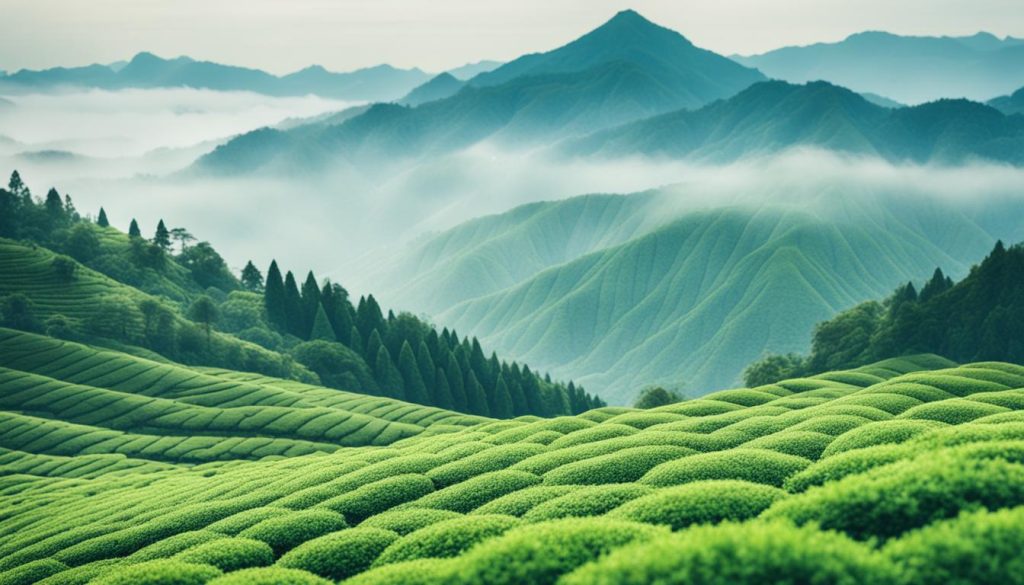
Aichi: Delicate and Refined Flavors
Aichi, situated in Japan, is renowned for its green tea that is cultivated at high altitudes. This unique geographical feature contributes to the creation of a delicate and refined flavor profile. As a result, Aichi green tea is highly regarded for its gentle and refreshing taste, subtle sweetness, and smooth finish. The tea leaves from Aichi are carefully nurtured, ensuring that each cup delivers a pleasant and satisfying sensory experience.
The delicate flavors of Aichi green tea can be attributed to the region’s optimal growing conditions, including the high altitude, favorable climate, and nutrient-rich soil. These factors combined create an environment where the tea plants can thrive and develop their distinctive flavors. This attention to detail and commitment to quality in tea farming practices make Aichi a prime location for producing exceptional green tea.
When brewed, Aichi green tea releases a captivating aroma that further enhances the overall tea-drinking experience. The fresh scent envelops the senses, invigorating both the mind and body. It is this sensory richness that sets Aichi green tea apart, making it a preferred choice for tea connoisseurs seeking a refined and pleasurable tea-drinking experience.
| Characteristics of Aichi Green Tea | Flavor | Aroma | Finish |
|---|---|---|---|
| Delicate and refined | Mild to medium-bodied with a gentle and refreshing taste | Fresh and captivating | Smooth and satisfying |
Tea Farm Experiences in Japan
A visit to a Japanese tea farm provides a unique opportunity for tea enthusiasts to immerse themselves in the culture and history of Japan’s tea regions. At these tea farms, visitors can participate in tea picking, tea tasting, and even learn about the tea production process. It’s a hands-on experience that allows you to appreciate the exceptional flavors and craftsmanship of Japanese teas.
Japanese tea tours and farm visits are available in various regions, offering a glimpse into the world of tea farming and the intricacies of tea production. Whether you’re a seasoned tea connoisseur or just starting to explore the world of tea, these experiences provide insights into the cultivation, processing, and brewing techniques specific to each region.
Tea Picking
One of the highlights of tea farm visits is the opportunity to participate in tea picking. This hands-on experience allows you to connect with nature and understand the labor-intensive process of harvesting tea leaves. As you pluck the delicate leaves from the bushes, you’ll gain a deeper appreciation for the craftsmanship and dedication required to produce high-quality Japanese teas.
Tea Tasting
No tea farm visit is complete without a tea tasting session. You’ll have the chance to savor a variety of tea styles, from delicate sencha to fragrant matcha. Experienced tea masters will guide you through the tasting, explaining the unique characteristics of each tea and offering insights into the flavor profiles influenced by different growing regions and cultivation methods.
Tea Production Process
During your visit, you’ll also learn about the intricate process of tea production. From withering and rolling to steaming and drying, you’ll witness firsthand the steps involved in transforming freshly plucked leaves into the distinctive teas enjoyed around the world. Understanding these processes deepens your appreciation for the artistry and tradition behind Japanese tea production.
| Benefits of Tea Farm Experiences | Japanese Tea Tours | Tea Farm Visits |
|---|---|---|
| Immerse yourself in the culture and history of Japanese tea regions. | Explore different tea farms and their unique characteristics. | Learn about the tea production process. |
| Participate in the labor-intensive process of tea picking. | Experience a tea tasting session guided by tea masters. | Gain a deeper appreciation for Japanese teas. |
| Understand the craftsmanship and dedication behind tea production. | Discover the diverse flavors and qualities influenced by growing regions. | Connect with nature and the origins of your favorite tea. |
Visiting a Japanese tea farm is a memorable and educational experience that allows you to fully embrace the world of Japanese tea. Whether you choose to tour tea farms in Kyoto, Shizuoka, Kagoshima, or other regions, each visit offers a unique perspective on the rich heritage and exceptional craftsmanship that define Japanese teas.
The Significance of Terroir in Green Tea
Just like with wine, the concept of terroir plays a significant role in the flavors and qualities of green tea. Terroir refers to the combination of factors that influence the growth and development of tea plants, including soil quality, weather patterns, altitude, and geographical location. These elements contribute to the unique characteristics of green tea from different regions, resulting in a diverse range of flavors and aromas.
The impact of the growing environment on tea is particularly evident in the case of green tea. The delicate leaves of green tea are highly susceptible to absorbing the nuances of their surroundings. The soil composition, rich in minerals and nutrients, interacts with the tea plant’s root system, influencing the flavor profile of the tea. Additionally, the weather patterns, such as temperature, humidity, and sunlight exposure, can impact the chemical composition of the leaves, resulting in variations in taste and aroma.
Each region has its own distinct terroir, affecting the character and quality of the green tea produced. For example:
Uji, Kyoto:
Uji in Kyoto Prefecture is renowned for its high-quality matcha, the powdered green tea used in traditional Japanese tea ceremonies. The tea farms in Uji benefit from fertile soil, mild temperatures, and abundant rainfall, creating the ideal conditions for growing matcha. As a result, Uji matcha is known for its vibrant green color, umami flavor, and smooth texture.
Shizuoka:
Shizuoka Prefecture, located near Mount Fuji, is Japan’s largest tea-producing region. The volcanic soil, combined with the cool mountain climate and ample sunlight, contributes to the distinctive flavor of Shizuoka green tea. The teas produced in Shizuoka often exhibit a fresh and vegetal taste with subtle hints of sweetness.
Kagoshima:
In southern Kyushu, Kagoshima Prefecture offers a warm and humid climate that is ideal for tea cultivation. The teas from Kagoshima are known for their balance, body, and deep umami flavors. The region’s volcanic soil, coupled with the unique weather patterns, gives Kagoshima green tea its characteristic richness and complexity.
The influence of terroir on green tea is an essential aspect that contributes to the appreciation and diversity of this beloved beverage. Understanding the impact of the growing environment allows tea enthusiasts to explore the subtle variations in flavors and aromas that arise from different regions. By embracing the concept of terroir, we can deepen our understanding and enjoyment of the remarkable world of green tea.
Authenticity of Famous Tea Styles
When it comes to famous tea styles, authenticity is paramount. Many products claim to be a certain tea style, but not all of them are grown or produced in the traditional regions known for that tea. It is important to identify high-quality tea and experience the true flavor of each famous tea variety.
Experienced tea lovers have developed a keen sense to identify authentic tea through taste and aroma. They can distinguish the subtle nuances that make each tea style unique. However, for newer tea drinkers, it may be helpful to seek guidance to ensure they are getting the real deal. By learning about traditional tea regions and understanding the characteristics of authentic tea, tea enthusiasts can confidently explore and appreciate the world of tea.
Identifying High-Quality Tea
Identifying high-quality tea goes beyond just examining the packaging or labels. It requires knowledge about the traditional tea regions and the characteristics that define each tea style. Here are some key factors to consider when determining the authenticity and quality of a tea:
- Origin: Authentic tea varieties are often associated with specific regions or countries. For example, Darjeeling tea from India and Matcha from Japan have well-established reputations.
- Traditional Production Methods: Each tea style has its unique production process. Familiarize yourself with these methods to recognize the true essence of a particular tea.
- Appearance: High-quality tea leaves are whole, unbroken, and often uniform in size. They may have distinct colors, shapes, and textures.
- Fragrance: Authentic teas have distinctive aromas that vary depending on the tea style. Delicate floral notes, grassy undertones, or earthy scents are common characteristics to look for.
- Flavor: The taste of authentic tea is a reflection of its origin and production methods. Each tea style offers a unique flavor profile, ranging from floral and vegetal to bold and robust.
By paying attention to these factors, tea enthusiasts can ensure they are drinking genuine, high-quality tea that captures the essence of its traditional origins. Now let’s explore some of the famous tea styles and their authentic varieties.
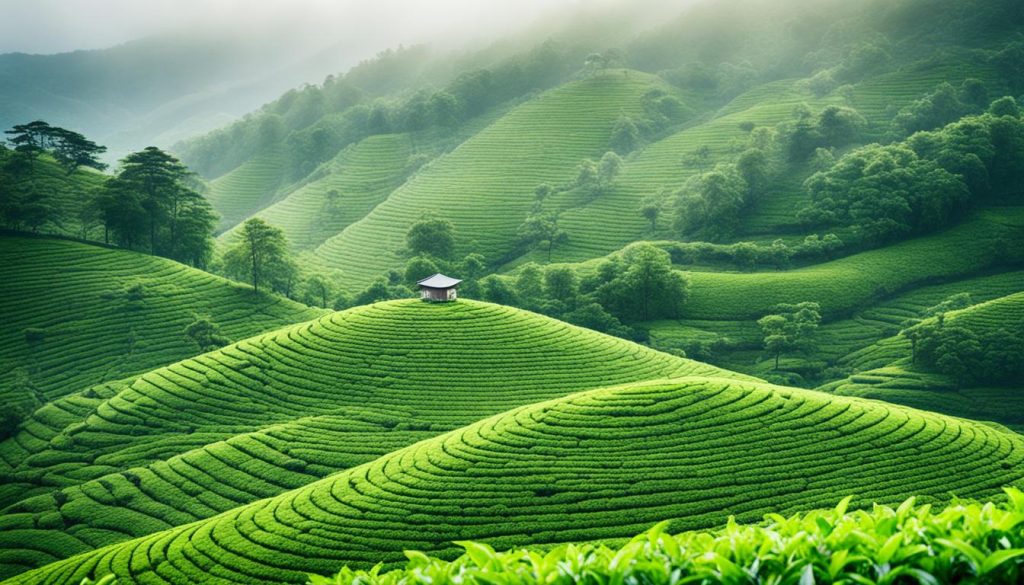
Famous Tea Styles and Their Authentic Varieties
| Tea Style | Traditional Tea Region | Authentic Varieties |
|---|---|---|
| Matcha | Uji, Kyoto, Japan | Uji Matcha |
| Sencha | Kagoshima, Japan | Kagoshima Sencha |
| Gyokuro | Yame, Fukuoka, Japan | Yame Gyokuro |
| Darjeeling | Darjeeling, India | Darjeeling First Flush |
| Oolong | Fujian, China | Tie Guan Yin |
These are just a few examples of famous tea styles and their authentic varieties. Each tea style has its own traditional tea regions, where the specific growing conditions and centuries-old cultivation techniques contribute to the exceptional flavors and qualities of the teas. Exploring these authentic varieties allows tea enthusiasts to experience the true essence of each tea style.
Remember, the authenticity and quality of tea play a significant role in the overall tea-drinking experience. By choosing authentic tea varieties from traditional tea regions, you can fully immerse yourself in the rich and diverse world of tea.
The Art of Brewing Green Tea
Brewing green tea is a delicate and precise process that involves various techniques and methods. Whether you’re practicing traditional tea ceremonies or experimenting with modern brewing techniques, mastering the art of brewing green tea can significantly enhance your tea-drinking experience.
To brew green tea correctly, it’s essential to pay attention to water temperature, steeping time, and tea-to-water ratio. Each green tea variety may have specific brewing requirements, so it’s crucial to follow the recommended guidelines for your chosen tea.
- Water temperature: Green tea is sensitive to water temperature, and brewing with water that’s too hot can result in a bitter taste. Generally, green tea is brewed with water between 160°F (71°C) and 180°F (82°C). If using a kettle, wait for the water to cool slightly after boiling before pouring it over the tea leaves.
- Steeping time: The steeping time for green tea usually ranges from 1 to 3 minutes. Steeping for too long can lead to a bitter taste, while steeping for too short a time may result in a weak brew. It’s essential to follow the recommended steeping time for the specific green tea you’re brewing.
- Tea-to-water ratio: Finding the right tea-to-water ratio is crucial to achieve the desired strength and flavor. As a general guideline, use about 2 grams (1 teaspoon) of tea leaves for every 8 ounces (240 ml) of water. Adjust the amount according to your preference.
Aside from these basic brewing parameters, the infusion vessel you choose can also impact the flavors and aromas of your green tea. Traditional Japanese tea ceremonies often involve the use of a chawan (tea bowl), a chashaku (tea scoop), and a chasen (bamboo whisk) to whisk the powdered matcha.
Experimenting with different brewing techniques can help you discover new flavors and nuances in your green tea. For example, you can try cold brewing green tea overnight for a refreshing iced tea, or use a kyusu (Japanese teapot) for a more concentrated brew.
The art of brewing green tea extends beyond just the technical aspects—it also encompasses the appreciation of the tea’s aroma, taste, and appearance. By engaging in the art of brewing green tea, you can fully immerse yourself in the rich traditions and flavors of this beloved beverage.
Traditional Tea Ceremonies
Traditional tea ceremonies, such as the Japanese chanoyu, are steeped in history and symbolism. These ceremonies provide a deeper understanding of tea culture and emphasize the importance of mindfulness and simplicity.
During a traditional tea ceremony, every step is executed with precision and grace—from the cleaning of the tea utensils to the whisking of the matcha. The ceremony often follows a specific sequence and includes elements such as the tokonoma (a traditional alcove), calligraphy, and seasonal decorations.
Participating in a traditional tea ceremony can be a transformative experience, allowing you to connect with centuries-old traditions and appreciate the beauty and serene ambiance of tea preparation.
Mastering the art of brewing green tea and embracing the traditions of tea ceremonies can elevate your tea-drinking experience and deepen your understanding of this ancient beverage.
Embracing the World of Japanese Tea
Are you ready to embark on a captivating journey into the world of Japanese tea? Whether you’re a connoisseur of matcha, sencha, gyokuro, or other Japanese teas, exploring the diverse flavors and traditions of Japanese tea culture is a truly enriching experience.
Each region in Japan boasts its unique tea varieties, cultivated with meticulous care and steeped in rich history. From the bustling tea plantations of Shizuoka to the serene tea farms of Uji, every sip of Japanese tea reveals the craftsmanship and devotion that goes into its production.
Immersing yourself in Japanese tea culture allows you to discover the intricacies of green tea in Japan. Learn about the traditional cultivation techniques employed by generations of tea farmers and delve into the rituals of tea ceremonies that have been preserved for centuries. By exploring Japanese teas, you can gain an appreciation for the artistry and dedication that make these teas truly exceptional.
